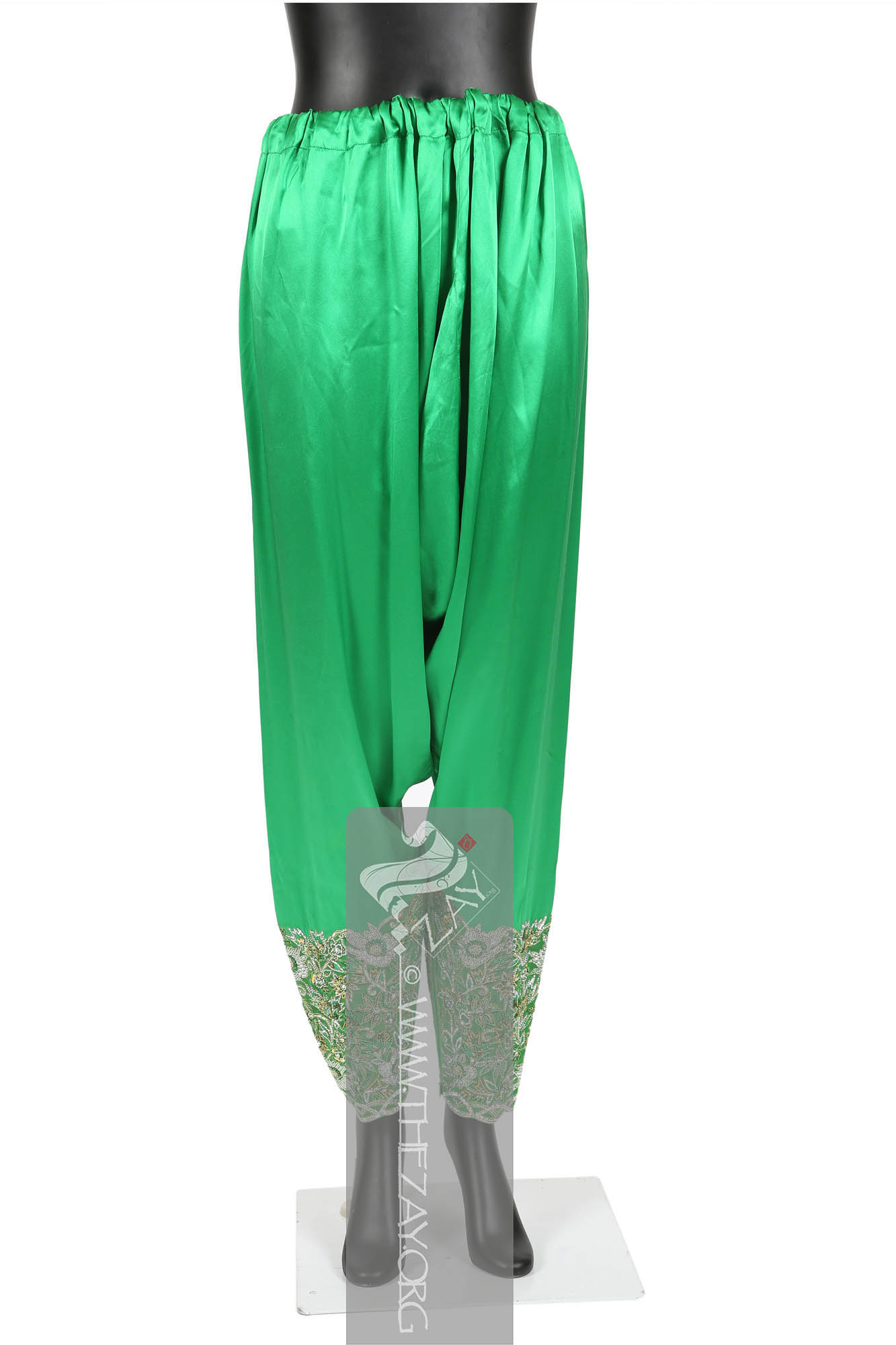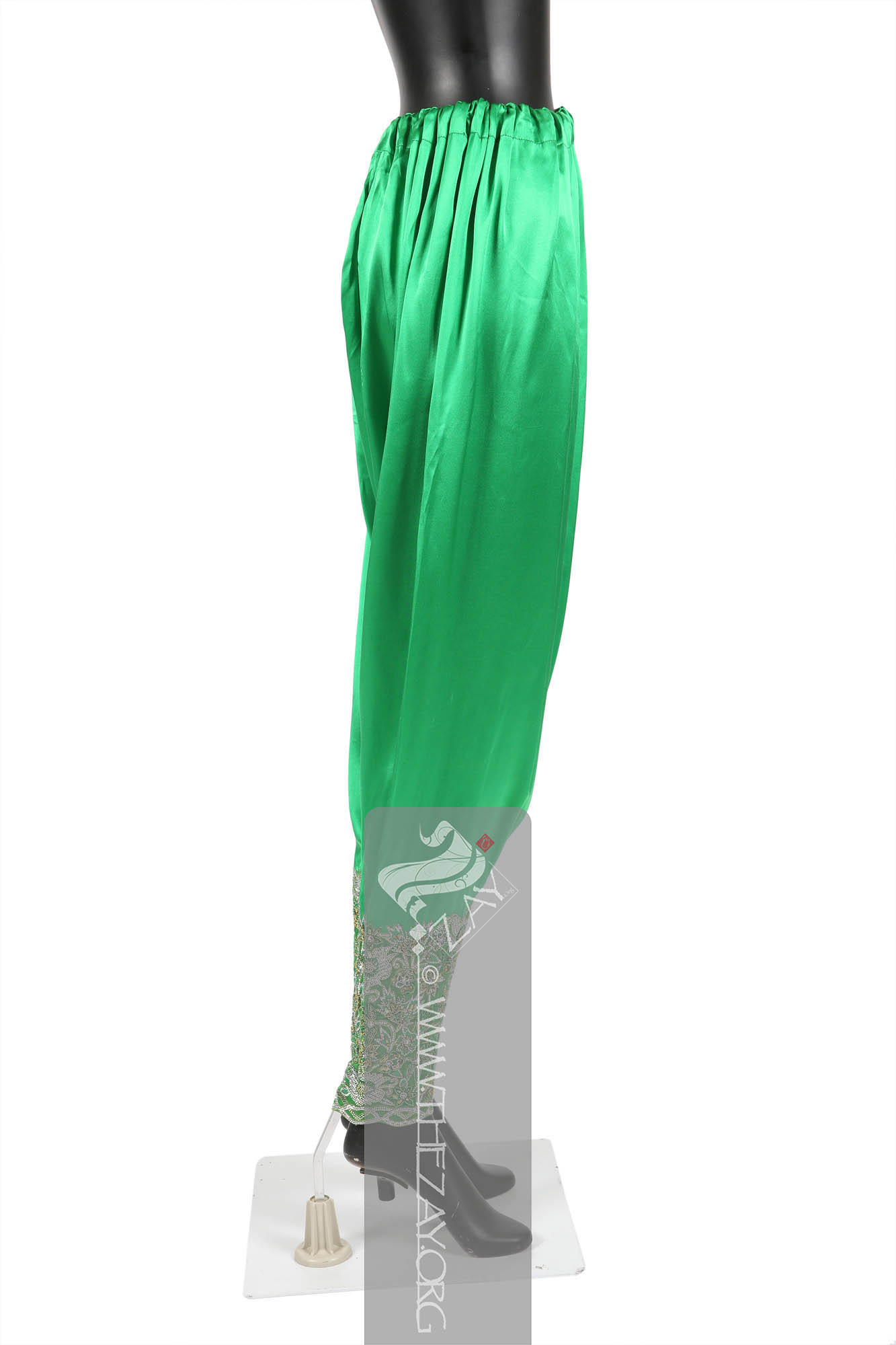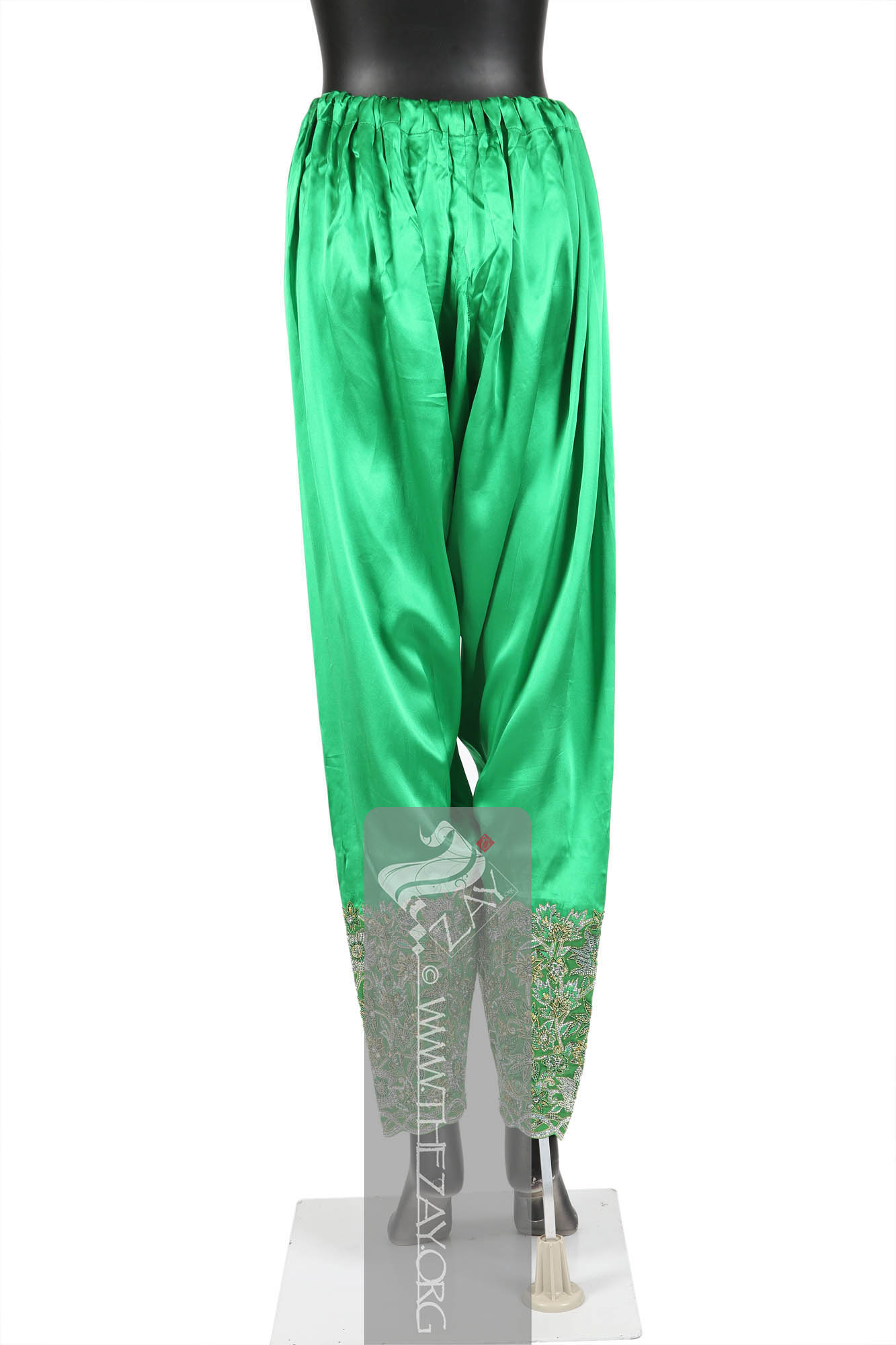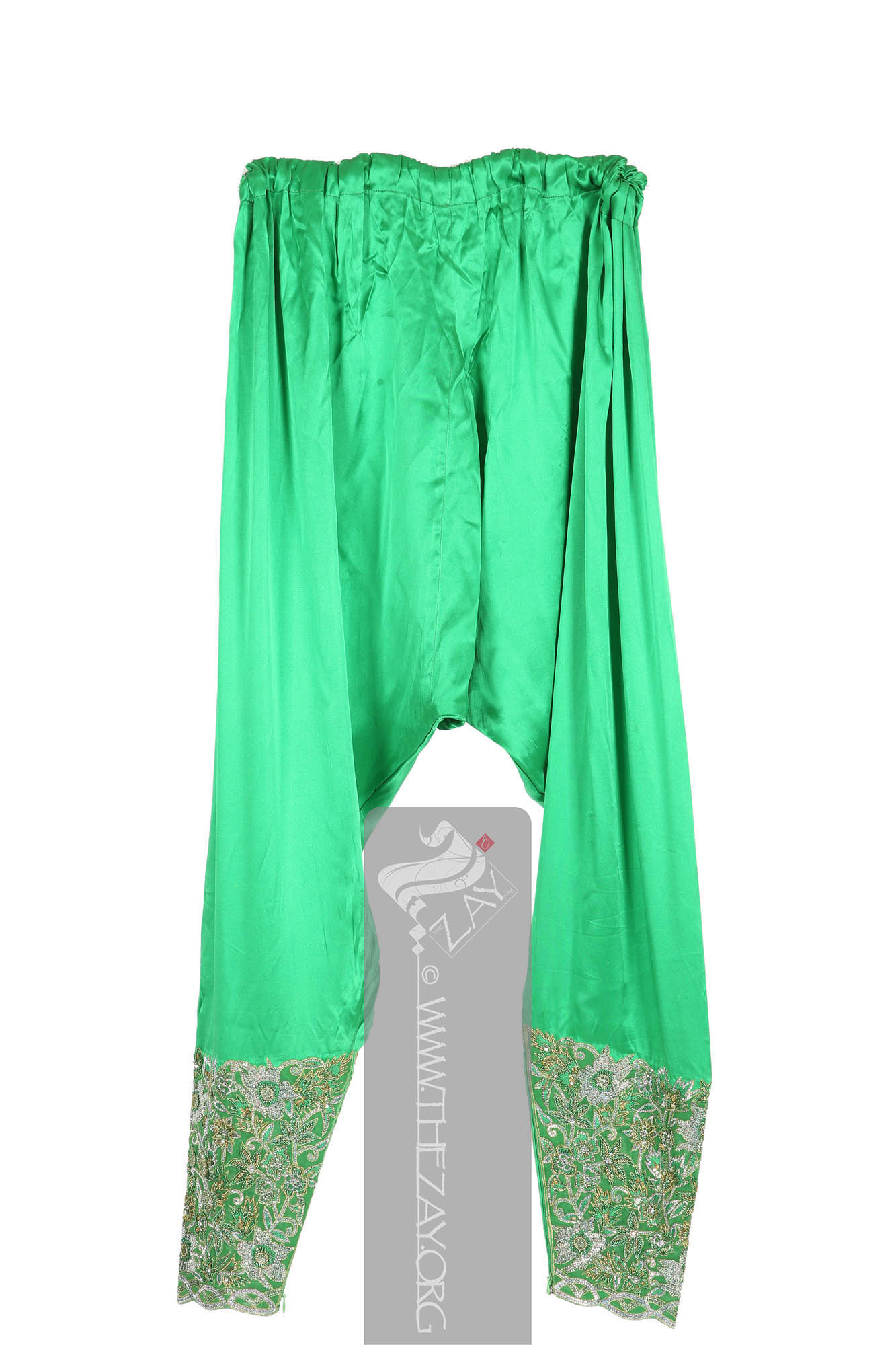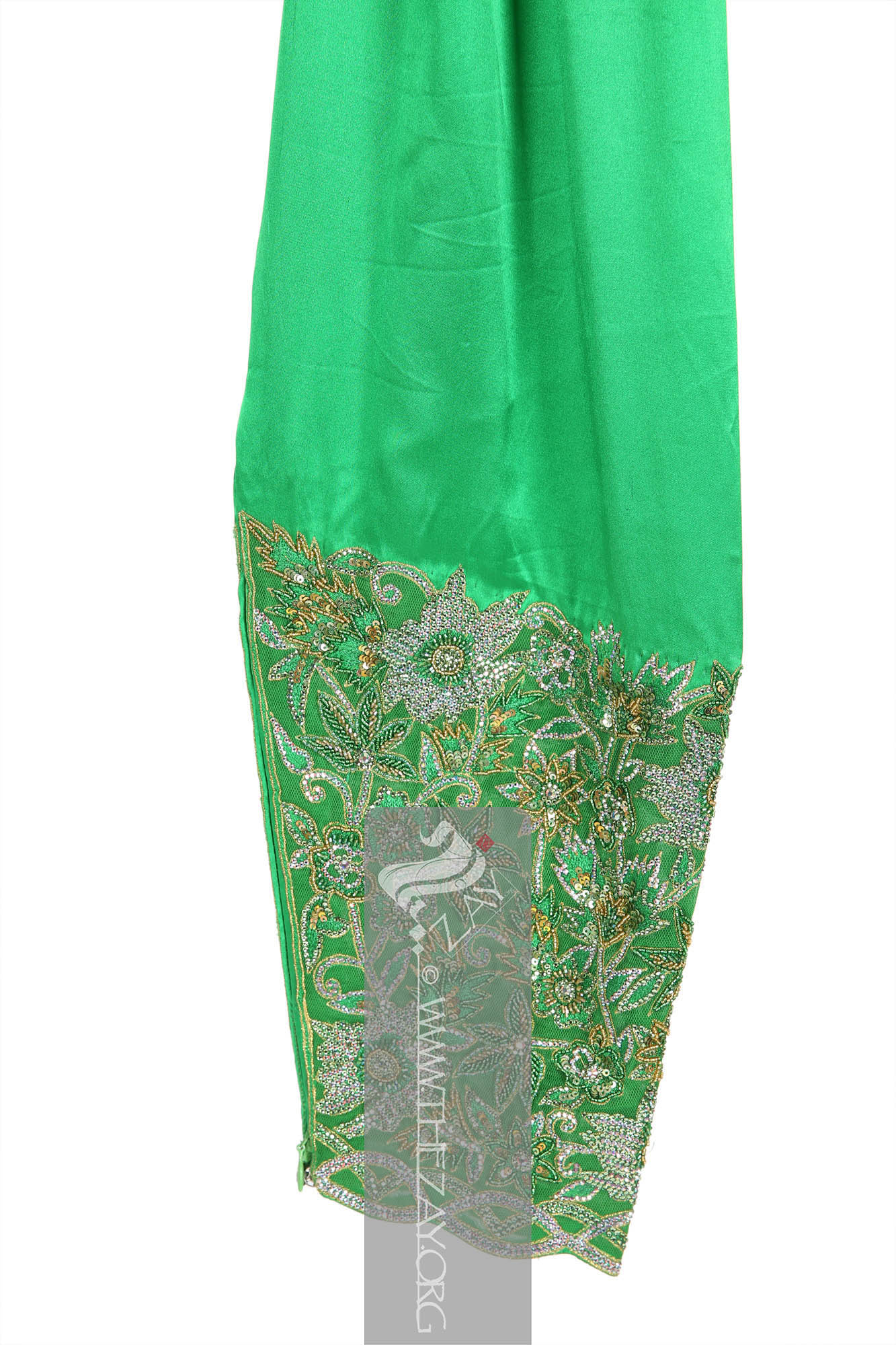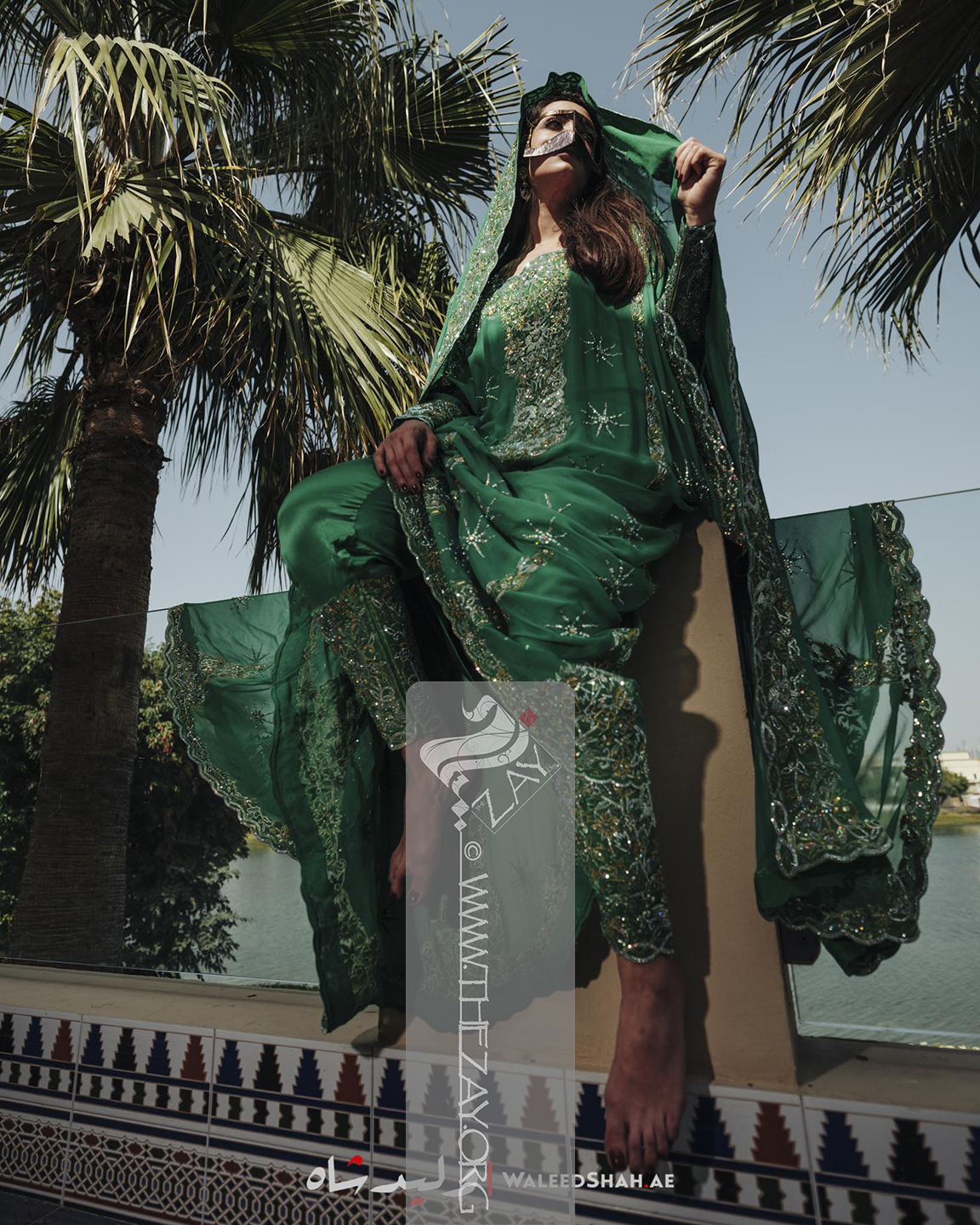Object Note This undergarment (
sarwal
Ṣarwāl: (Farsi: shalvār; Synonym: salwar, shirwāl), trousers featuring tapering ankles and drawstring closure of Central Asian origin. They disseminated in the Indian subcontinent between c.1st-3rd century BCE. Although exact period of its arrival in the Arab world is disputed their widespread adoption is confirmed from the 12th century.
) is part of a three-piece ensemble, a combination overgarment tunic (
thawb_kandurah
Thawb_kandūrah: (colloquial, UAE), post-1990s the (Thawb_wa_kandūrah) ensemble of the eighties evolved where the overgarment (thawb) and tunic (kandūrah) became united at the neckline creating one outfit and inner tunic receding to act as lining.) (
ZI2018.50082 UAE) and veil (
shaylah
Shaylah: (Colloquial Gulf Arabic), a length of fabric used as shawl, head cover or veil. Also known as (wigāyah) or (milfa’), generally made from sheer fabrics such as tulle (tūr), cotton gauze (wasmah
Wasmah: (Arabic: woad), is derived from the woad herb (wasmah) used to dye the cotton gauze black. It is mainly used for headcovers or veils and overgarments in most of the Arab gulf region.) (nidwah) or (Nīl), or silk chiffon (sarī).) (
ZI2018.50082a UAE).
Object History The complete
hinnah
ḥinnah: (Arabic: ḥinnāʾ), an Asian or African plant, the leaves are dried and made into a paste used to dye the hair and decorate parts of the body. (https://thezay.org/henna/) ceremony outfit was worn by Sheikhah Mariam bint Said bin Tahnoun Al Nahyan of Abu Dhabi on her
hinnah
ḥinnah: (Arabic: ḥinnāʾ), an Asian or African plant, the leaves are dried and made into a paste used to dye the hair and decorate parts of the body. (https://thezay.org/henna/) night (
laylat_al_hinnah
Laylat_Al_ḥinnah: (Arabic: laylat: night, ḥinnah: henna), a ceremonial ritual celebrated among family and close friends, carried out in the days before bride's wedding night. The hands and feet are decorated using henna paste as an integral part of the ceremony.) before her marriage to Sheikh Marwan bin Rashid Al Mualla of Umm al Quwain in 2010. It has only been worn on this one occasion. The outfit was designed, commissioned, and presented to Sheikha Mariam by her aunt Sheikhah Moza bint Hamdan al Nahyan.
Dr. Reem Tariq
Ṭariq: (Arabic; Synonym: tulle_bi_talli
Tūlle_bi_tallī: (French: Tulle – a city in France where fine material for veil was first made; Turkish: tel – wire; Synonym: tariq; talli; badla; khus_dozi ), series of small metal knots made on a woven net ground as embellishment. The term is commonly used in the North African Arab region specifically in Egypt.
; talli; badla; khus_dozi ), series of small metal knots made on a woven net ground as embellishment. The term is commonly used in the Levant Arab region specifically in Lebanon.
el Mutwalli
Dr. Reem Tariq
Ṭariq: (Arabic; Synonym: tulle_bi_talli
Tūlle_bi_tallī: (French: Tulle – a city in France where fine material for veil was first made; Turkish: tel – wire; Synonym: tariq; talli; badla; khus_dozi ), series of small metal knots made on a woven net ground as embellishment. The term is commonly used in the North African Arab region specifically in Egypt.
; talli; badla; khus_dozi ), series of small metal knots made on a woven net ground as embellishment. The term is commonly used in the Levant Arab region specifically in Lebanon.
el Mutwallī: Founder (CEO) of the Zay
Zay: (Arabic: costume, Pl. azyaā’), a set of clothes in a style typical of a particular country or historical period. Initiative, a public figure, speaker and author. An expert curator and consultant in Islamic art and architecture, interior design, historic costume, and UAE heritage. has known Sheikhah Mariam from birth, as she is a childhood friend of her mother Sheikha Fakhira bint Mubarak al Nahyan. We are fortunate to have a few of the young Sheikha’s gowns from her youth in The
Zay
Zay: (Arabic: costume, Pl. azyaā’), a set of clothes in a style typical of a particular country or historical period. collection.
Object Features Before the advent of oil wealth in the Gulf region, an Emirati
hinnah
ḥinnah: (Arabic: ḥinnāʾ), an Asian or African plant, the leaves are dried and made into a paste used to dye the hair and decorate parts of the body. (https://thezay.org/henna/) night called
laylat_al_hinnah
Laylat_Al_ḥinnah: (Arabic: laylat: night, ḥinnah: henna), a ceremonial ritual celebrated among family and close friends, carried out in the days before bride's wedding night. The hands and feet are decorated using henna paste as an integral part of the ceremony. had traditionally been a modest affair, attended mainly by close friends and family. The increase in wealth and the subsequent rise in social competitiveness, along with the use of the colour green for
hinnah
ḥinnah: (Arabic: ḥinnāʾ), an Asian or African plant, the leaves are dried and made into a paste used to dye the hair and decorate parts of the body. (https://thezay.org/henna/) ceremony clothes, appeared in the UAE from the 1980s imported from neighbouring countries. Not only did these new traditions lead to greater pageantry and displays of opulence, with music, food and singing, but the number of attendees increased to include at times hundreds of people, now including more distant relatives and a wider circle of friends, colleagues and acquaintances. The clothes that concealed the bride while sitting on a small raised stage, became the centrepiece of this desire to display as manifested in the pieces from this ensemble.
The entire
hinnah
ḥinnah: (Arabic: ḥinnāʾ), an Asian or African plant, the leaves are dried and made into a paste used to dye the hair and decorate parts of the body. (https://thezay.org/henna/) night ensemble is a reflection of the amalgamation of old and new, local and imported customs. While honouring the tradition of hiding the bride, more elaborate approaches were devised to highlight her during the ceremony.
The undergarment is a testament to the sophisticated craftsmanship reached locally, when compared to work from the past century.
The cuff embellishments are now elaborate, and match the rest of the ensemble. The floral motifs are hand embroidered (
shak
Shak: (Arabic: to prick with a needle), Colloquially in the Arab gulf region it refers to the art of hand embellishing garments with beads.) in gold and crystal multi-shaped glass beads and sequins (
folak
Folak: ( Persian: polk), arabised, refers to sequins used to decorate clothes. Also known as (tirtir
Tirtir: (Arabic: sequins), small round disks used to decorate clothes. Also known as (lama’a), (barq), and (bareeq) – all meaning to shine. Believed to originate in the Indus Valley during the Kot Diji civilization circa 3300 BC then spread to surrounding countries. In the past, sequins were handcrafted from seashells, copper, silver, or gold. Today, sequins can be made of coloured plastic, in various geometric or figurative shapes, including flat, concave, circular, or hexagonal.).) on to an emerald green mesh or tulle (
tur
Tūr: (Arabised from French: tulle), refers to a net-like soft, fine silk, cotton, or nylon material, used for making veils and dresses. In colloquial Arabic the letter (L) is turned into (ra). ) fabric. This is then cut to shape and the tulle is applied to key sections of the garment, as evident on theses ankle cuffs (
badlah
Bādlah: (Hindustani: badal – cloud from Sanskirt: vārdala – water; Synonym: tariq; talli
Tallī: (Turkish: tel – wire, string), Gulf Arab – a woven braided trimming made with metal wire, threads and ribbons often sewn on detachable panels used as embellishments. Other – (Synonym: tulle_bi_talli
Tūlle_bi_tallī: (French: Tulle – a city in France where fine material for veil was first made; Turkish: tel – wire; Synonym: tariq; talli; badla; khus_dozi ), series of small metal knots made on a woven net ground as embellishment. The term is commonly used in the North African Arab region specifically in Egypt.
; tariq; badla; khus_dozi), series of small metal knots made on a woven net ground as embellishment.
; tulle_bi_talli
Tūlle_bi_tallī: (French: Tulle – a city in France where fine material for veil was first made; Turkish: tel – wire; Synonym: tariq; talli; badla; khus_dozi ), series of small metal knots made on a woven net ground as embellishment. The term is commonly used in the North African Arab region specifically in Egypt.
; khus_dozi
Khus_dozi: (Persian: Khvosh – an Iranian province; dozi – needlework; Synonym: tariq; talli
Tallī: (Turkish: tel – wire, string), Gulf Arab – a woven braided trimming made with metal wire, threads and ribbons often sewn on detachable panels used as embellishments. Other – (Synonym: tulle_bi_talli
Tūlle_bi_tallī: (French: Tulle – a city in France where fine material for veil was first made; Turkish: tel – wire; Synonym: tariq; talli; badla; khus_dozi ), series of small metal knots made on a woven net ground as embellishment. The term is commonly used in the North African Arab region specifically in Egypt.
; tariq; badla; khus_dozi), series of small metal knots made on a woven net ground as embellishment.
; tulle_bi_talli
Tūlle_bi_tallī: (French: Tulle – a city in France where fine material for veil was first made; Turkish: tel – wire; Synonym: tariq; talli; badla; khus_dozi ), series of small metal knots made on a woven net ground as embellishment. The term is commonly used in the North African Arab region specifically in Egypt.
; badla), series of small metal knots made on a woven net ground as embellishment. The term is commonly used in Iran and parts of the Arabian Peninsula possibly because Khvosh was one of the centres for the craft.
), series of small metal knots made on a woven net ground as embellishment. The term is commonly used in India and parts of the subcontinent.
).
The baggy waistline is gathered and fixed in place with elasticated band replacing earlier more traditional cotton cord (
nsai’ah
Nsai’ah: (Arabic: diminutive of nis’ah: belt). A woven cotton or wool spun flat cord, used to gather and fasten underpants on to the waist. Also used to denote any chevron motif.). The more tapered legs with embroidered ankle-cuffs are opened and closed with the aid of a zipper. Earlier versions used traditional cotton thread ball buttons (igam) and more recent, metal snap studs (
siq_w_biq
Siq_w_biq: (Colloquial Arabic), metallic snap studs used to fasten clothing. The term in an onomatopoeia representing the sound that the snaps make when opening and snapping shut.).




